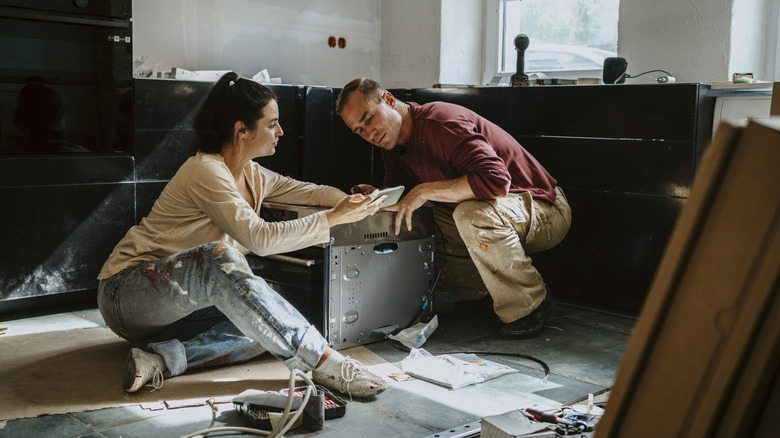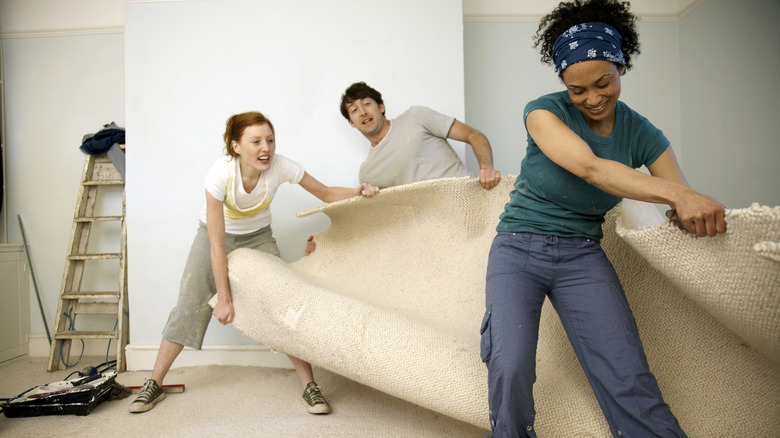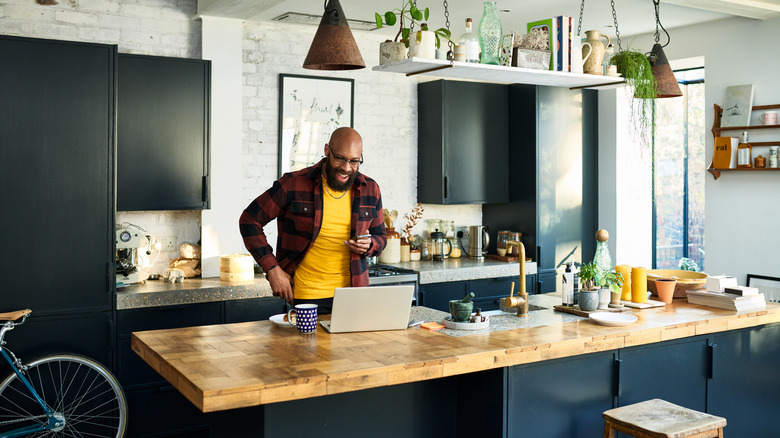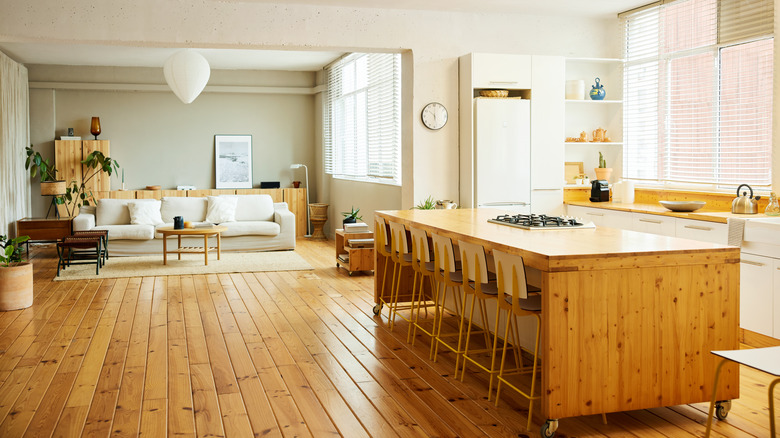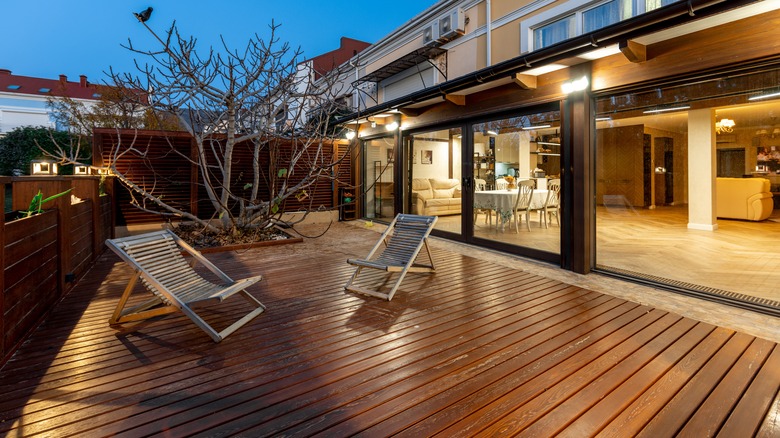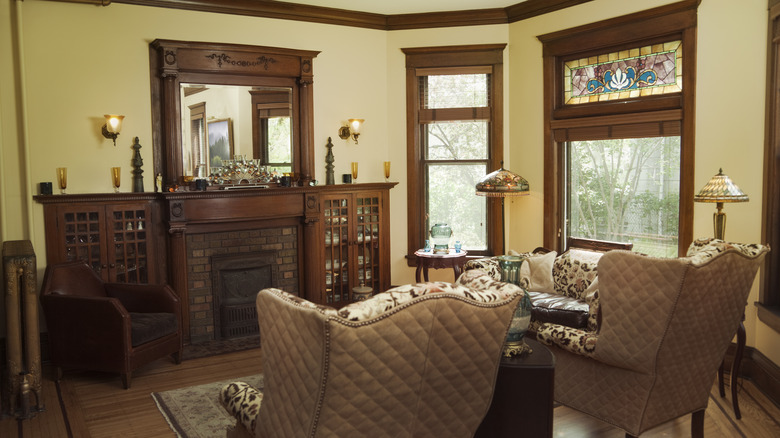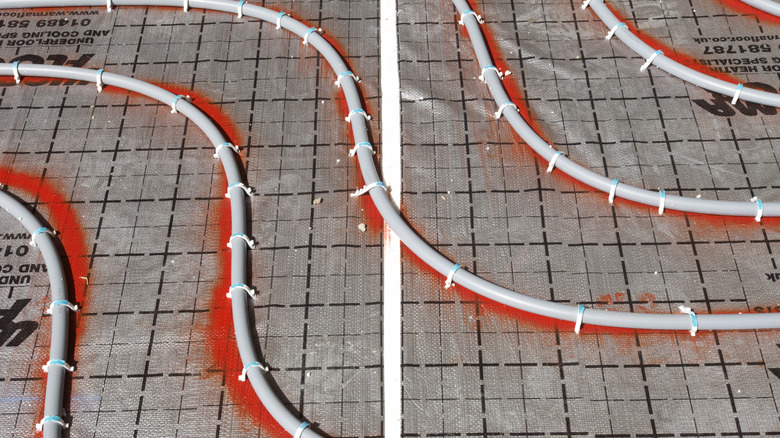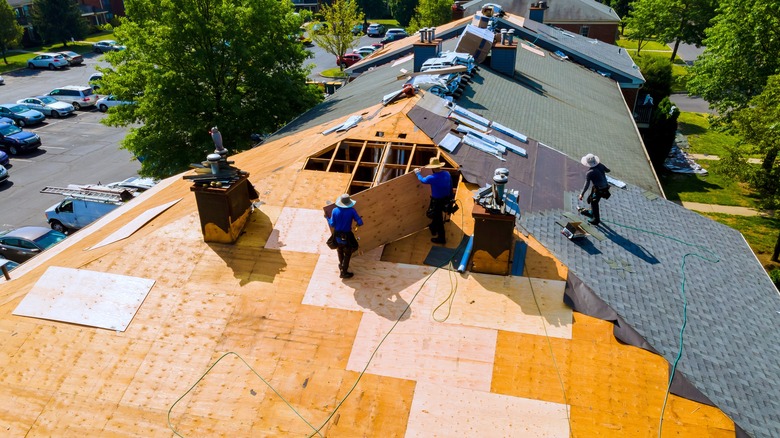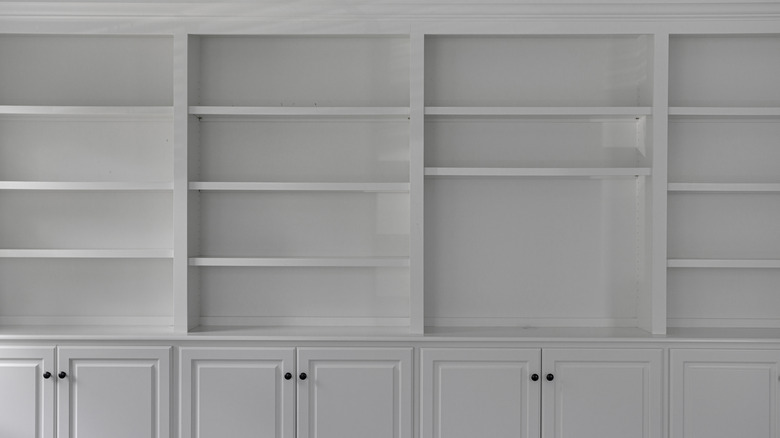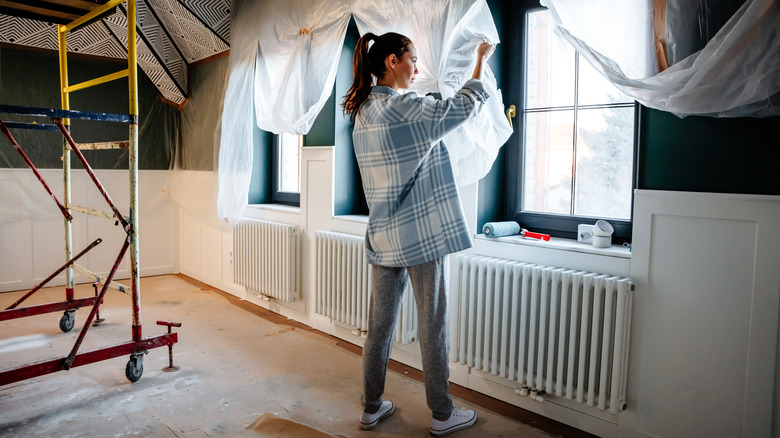Don't Waste Your Money On These Home Upgrades Or You'll Be Sorry
The task of renovating a home to make it perfectly fit your vision is a daunting one. There's seemingly a never ending to-do list when it comes to making improvements. Replacing the flooring in one room inevitably leads to a skirting board replacement that ends in updated crown moldings throughout the house, and more. The nature of homeownership is one of constant changes, even if those operate as small scale tweaks to the property in most instances.
Across the board, however, there's the natural inclination to balance a desire for improvement, change, and modernization with a realistic budget (perhaps with the help of a balanced home improvement loan). There's no substantive benefit to introducing brand new furniture or building an extension if it tanks your finances for months or years to come. Unfortunately, there's also an inclination to engage in moderate or even large-scale home improvement projects ahead of listing a home for sale, too. Rather than investing in your property to improve the value it brings to your life, this approach will see you invest money in the property in the hopes of boosting its resale value (ideally by more than you spent to make the changes). This doesn't always work out, and there are actually plenty of renovation opportunities that frequently fail to bring extra value back. Whether you're renovating for your own benefit or looking for changes that can boost interest in your home ahead of a sale, these are some of the home upgrades that tend to end up feeling wasteful instead of helpful.
Replacing the carpet
Carpeting is a common sight in bedrooms and other living areas of the home trending away from functional and toward comfort. Anywhere where you might want to relax and slow the pace down might be a good candidate for carpeting. But this flooring feature isn't always the best choice, even in comfort-focused areas of the house like your bedroom or a children's play area. Carpeting must be replaced on a more regular schedule than hard surface options. Carpet can last up to 10 or 15 years if it's well cared for, but you'll often want to swap out the soft surface far sooner, closer to the five year mark (or even sooner if you're a pet owner). Alternatively, a hardwood floor that you take steps to protect can last a lifetime. Tile will remain a viable flooring solution for even longer (so long as the selection remains relevant enough to jive with other stylistic elements).
This makes carpeting a much more fleeting option, and one that isn't without its problems. Instead of carpeting your home, you could put down laminate or hardwood floors throughout the property and then introduce area rugs to soften the visual and introduce a comforting, tactile responsiveness. In addition to durability issues that affect its value as an investment for your living space, carpeting is often something that buyers don't want to see in properties they're exploring. If you're gearing up to sell your home, leaving the flooring as it is or investing in a genuine upgrade rather than just re-carpeting the space is a must.
A custom kitchen
Kitchens are a deeply personal area of the home. Everyone will be looking for something unique in the layout and setup of their cooking and eating space. Some want a breakfast bar or seated nook area, others want to work around an island as they whip up meals for friends and family. There's no single right way to lay out the kitchen. Because of this, making upgrades in advance of a sale the focus on the kitchen can easily become a fool's errand. Pouring money into this space feels like a great idea. Elevating the kitchen can make the whole home feel more luxurious, but this is a big gamble that doesn't always pay off. The kitchen is often one of the areas of the home that new buyers will immediately seek to renovate. Whether you just upgraded the space or not, pulling out cabinets and tinkering with the set up is to be expected among even the most conservative of home buyers.
Because of this natural inclination to reconfigure things in this personalized space, making upgrades to your kitchen should only be done if you intend on continuing to live in the home and using the cooking facilities over the medium to long term. Kitchens are not and ideal area of the house to make changes to if you're planning a sale, but they can be a massively impactful change of pace for someone who has just moved into a home or intends on continuing to live in their property long into the future. Personalize at your peril here.
Knocking down walls in pursuit of an open floor plan
The open floor plan is something that many people love, or at least they think they do. The open floor plan is certainly something to admire. Wide open spaces and plenty of freedom to move around communal areas makes for a home that feels large, inviting, and comfortable. On the surface it acts as a fantastic way to create a wonderful place to spend time with friends and family. Open plan living can be a challenge, especially for those who don't understand the broader context of the decision. First of all, images that inspire a major renovation of this sort stage the space to perfection. They are lit to exacting precision and furnished in ways that help make the entire space crackle with energy and exuberance. You also won't see much in the way of negativity here.
In order to fully enjoy this kind of home environment, you'll need to understand that some concessions must be made. An open plan household is much louder than that of a traditional layout. Without walls and other furnishings to intercept sound waves and redirect them, the voices, music, and typical sounds of life carry through the home with much greater resonance. You'll also need to take greater care to keep your living space clean. With the inability to close doors between rooms, messes left in one room can be seen from another, impacting the overall comfort experience in any part of the home.
Decking features and other, similar outdoor leisure areas
Outdoor living areas can make a big difference in the general comfort you enjoy. In many parts of the country, decking elements and other outdoor spaces make for major improvement to the lifestyle you can expect to have at home. Indeed, most places across the globe feature comfortable, if not downright beautiful, late spring and summer weather. It may be tempting to install a patio space or a deck outside your home to take greater advantage of this seasonal weather.
But wooden decking elements can be problematic for many homeowners. Investing in synthetic decking materials is an option, but this is far more expensive than installing a traditional wooden feature. This means that most renovators will opt for the standard installation. With this comes an added responsibility. Every year you'll need to reseal the deck in order to keep it healthy, secure, and safe. Wood experiences rot over time, and all sorts of insects and other animals can impact the integrity of your installation if you aren't careful. This can leave you with a decaying feature that quickly falls out of favor. Making matters worse, if you don't remain on top of maintenance tasks this lifestyle element can even act as a hindrance to your efforts to sell your home when the time comes to cash in on the asset and move somewhere new.
Major landscaping works
Much like decking elements, other outdoor landscaping tasks can easily become more trouble than they're worth. Basic lawn elements help improve curb appeal and can be a real point of pride to homeowners. A nice looking lawn acts as a great starting point in your property. It's the first thing people interested in buying your home will see, and therefore acts as a good first impression and mood setter. But this is really where landscaping efforts start and end.
In the same way that spaces inside your home can be extremely personal in nature, gardening features beyond a basic lawn can ultimately take away from the value of your home rather than add to it. Some people are avid gardeners and love tending to the plant life they've installed around the house. If gardening is something you enjoy, there's no reason not to invest your time and energy into personalizing this part of the property. However, a garden complete with your favorite homegrown crops and fruit trees can be a lot to take on for someone who might be interested in buying your home. As a means of improving resale value, sticking with the tried and true tactics of basic landscaping is far more advantageous.
The customized mantlepiece and surrounding storage areas
Many homes across America feature fireplaces and at least a basic mantelpiece installation. Whether your fireplace is something you use to deliver heat to the home or it only acts as a visual enhancement for the property, focusing on this element in your renovation tasks can be a financial pit. There's a lot to like about the idea of upgrading your mantle and installing customized functionality elements around the unit. Some homeowners might opt for a large and elongated brick step in front of the fireplace or build customize the bookshelves around the unit to complete the wall personal specifications. No matter what you might have in mind for this part of the house, you are likely tackling yet another intimately personal project that potential buyers won't tend to value as highly.
Homeowners who want to establish a reading nook, a place to store trophies and other awards, or something else that's deeply personal to them can get value out of this upgrade. But most people will find that sinking money into this niche project doesn't bring about the kind of return that they were hoping for when they launched the project.
Think twice about underfloor heating
Underfloor heating is all the rage in the present moment. Whether you live in a property that features central heating and air conditioning systems or you manage the indoor climate control tasks in another way, adding underfloor heating to one or more rooms in your home can feel like a major luxury. There's nothing quite as decadent as stepping on to the kitchen tile in the early winter morning and feeling a nice cozy warmth radiating upward rather than the bone-chilling touch of a typical tile floor. There's a lot to get excited about when it comes to heated flooring installations, to be sure.
But problems quickly arise for homeowners who have taken the plunge on this trending feature. Heating systems beneath the floor tend to be prioritized in rooms that feature tile. Unlike carpet or laminate flooring, tile can't easily be pulled up and then reinstalled without extreme hassle. Even hardwood flooring demands a significant amount of legwork to remove if a problem arises in your heating system down below. Tile is put down as a semi-permanent installation and having to dig it up to address an issue in your heating element is it costly operation that really puts a damper on things. Similarly, because this is a somewhat niche element it may even be considered something of a fad. This means that some buyers may not be interested in the feature and won't value your home in the same way that you see it.
Be careful about roof replacements, too
There's no getting around the fact that a failing roof needs to be remedied. The typical home requires a roof replacement every quarter-century or so. Depending on the material used in your last installation, this might be a bit longer or possibly somewhat sooner. All manner of chance encounters with the elements can also influence the long-term viability of your homes roof. If you've started to experience the signs of a failing installation, it will certainly be important to address the problem. However, making alterations to the roof when you don't need to act is a great way to waste money. Even a small-scale roof repair is a costly endeavor, and if you don't need to invest in the feature you shouldn't prioritize it.
Specifically, one area where homeowners get this task wrong is when they're gearing up to list their property for sale. Preemptively tackling a roof repair minimizes a seller's leverage. If the roof is falling apart, offering to repair it before closing can give buyers the ability to knock a few bucks off the price while controlling the costs of the job in a favorable way. Some buyers may not be concerned with the roof if it's still in decent shape and so sinking money into this repair might not be necessary at all.
A fully converted office space
In the modern working world, many homeowners have transformed one of their bedrooms into an office space to support their home working environment. Rather than setting up at the kitchen table and breaking down your workspace each day at the close of business, repurposing a room to support your "daily commute" is a much more efficient option. Creating a dedicated office space in your home can even bring about tax advantages when it comes time to tackle your yearly accounting needs with the IRS. There are a range of good reasons to make a temporary or even semi-permanent alteration to your property to create a home office.
But going all the way in on this project is frequently a mistake. Making structural alterations to the bedroom so that it becomes a genuinely permanent workspace in your home removes flexibility and can be a hindrance for those looking to sell their house and move to another area or downsize. Fortunately, most transformations of this sort don't feature major renovation works but rather a change of furniture and a bit of rearranging.
Converting a bedroom into a walk-in closet or dressing room
Another conversion that many homeowners make involves repurposing a spare bedroom into a walk-in closet or a dressing room. Creating space that allows you to organize your wardrobe in a wide open configuration is a great option for those who have the area to support it. Sprawling closets and dressing rooms with long mirrors and ample lighting are seen as luxurious amenities that frequently only feature in high end properties. But for those who have the space, a quick transformation of the furnishings and layout is all it takes to introduce this opulent lifestyle upgrade.
As is the case with any other repurposing task, it's generally a bad idea to go all in on the changeover. A homeowner looking to permanently create a walk-in might close up the door to the bedroom that reaches out into the hallway or some other communal area. Then they might knock down a portion of the wall to the adjacent room in order to deliver a genuinely private preparation space. Making substantial alterations like this creates a larger burden if you decide to repurpose the room once again or bring it back as a bedroom in advance of a sale opportunity. If you are going to tackle this kind of change, it's best to utilize updates that can be reversed without too much hassle.
Excessive amounts of built-in furniture and storage space
Built-in furnitureis having a moment in the present environment, too. Closets, wardrobe space, and cabinetry that is built into a room rather than existing as standalone furnishings can elevate the visual style tremendously. There's no getting around the elegance that a tasteful built-in piece of furniture can provide. However, there is a point of diminishing returns when utilizing these kinds of features.
Too much reliance on built-in furniture results in a living space that feels cramped and compact. A dresser sits in a room and doesn't functionally take away from the space that the area offers to person standing in it. Dressers and even tall closet furnishings don't reach all the way up to the ceiling, and so they feel like things you've placed in the space rather than something that changes it. Built-in storage solutions change the dimensions of your home. With too much of this placed in your living space, your property will begin to feel claustrophobic and small.
Eagerly jumping on every DIY upgrade project you find on social media
Finally, it's important to remain realistic when considering tackling upgrades and projects that you see online. Social media is swimming in inspirational photos, project designs, and build blogs that document the efforts of influencers and others. There's a massive subsection of the internet dedicated to renovation projects and the look and feel of a home that has benefited from one or more upgrades. In many instances, these documentary postings center on DIY renovations rather than work done with the help of a professional.
Full disclosure: I am a homeowner who spent roughly a year investing significant time in tackling fixes and upgrades throughout an older home. I'd never claim to be a professional, and the amount of time it took to lay down flooring, fix and paint walls, and improve little features like socket placement and attic lighting attest to my willingness to do it myself but also a lack of professional experience that might have otherwise made these tasks easy. DIY projects aren't for the faint of heart, and engaging in updates that follow trends outlined by influencers can ultimately leave you scratching your head. These content creators are out to get clicks and likes. They aren't usually documenting their struggles, and they certainly won't circle back and tell their viewers about projects that ultimately weren't worth their time or energy. Regrets are frequently embedded in the project of homeownership and home improvement, but you won't hear this portion of the endeavor from social media personalities.
